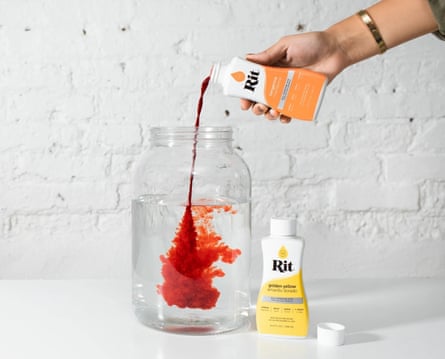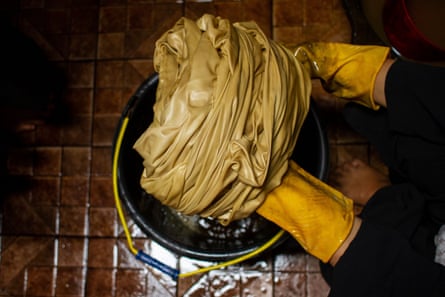
When I think about the concept of a wardrobe refresh, it’s usually framed as a cleanout, taking things to the tailor or adding styles that will complement existing pieces. But there is another way: using dyes to return faded garments to their original hues or change their colour altogether.
From natural dyes to at-home projects, there are solutions to breathe life back into stained and faded garments, though some dye jobs are best left to the professionals.
The basics
“Dyeing is really a lot of trial and error,” says Rebecca Van Amber, a textile scientist at RMIT University. Fibres such as cotton, linen, silk and viscose rayon take dyes well and can be dyed at home, whereas synthetic fibres such as polyester and nylon are more difficult to dye and should be handed over to a professional dyeing service. This is also true of particularly precious garments, where you want to be sure of the outcome.
Generally, garments can only go from light colours to darker colours, says Van Amber. For example, “A light pink shirt could be dyed to a darker pink or purple, or maybe black or brown.
“Keep in mind that things like nylon zips and most stitching, some linings, will [remain the] original colour after the dyeing process,” Van Amber cautions, since these are often made from synthetic fibres.
Dye DIY
If you are game enough to try your hand at dyeing, Van Amber recommends using a Rit Dye and says you must wear protective gloves and a mask.
Note the care label on the garment and compare it with the instructions on the dye packet. If a garment can’t be washed over a certain temperature it might not be compatible with at-home dyeing.
You can either dye garments in a plastic tub or in the washing machine. Be sure to triple check the instructions on the dye packet and follow them carefully.
The garment will need to be clean and wet before you dye it, so either put it through the wash or hand-wash it. Then you will need to fill your washing machine or plastic tub with the advised quantity of water, pour in the respective amount of dye, add a fixative such as salt or vinegar (depending on the fabric) and submerge your clothes in the water.
If you decide to use a tub, Van Amber says it’s important to stir continuously.
“The water has to keep moving and the garment has to be constantly agitated.”
The dyeing process usually takes from 30 minutes to an hour. “So it can be a bit of a tedious experiment sitting over pot constantly stirring a garment,” she says.
After that you will need to rinse the garment with warm water, followed by another wash cycle, before it is ready to be dried.
Natural dyes
Natural dyes can be a good option if you’re wary of chemical dyes, but there are more variables at play. “Natural dyeing involves firstly using a mordant to prepare your fibre, then using colour extracted from seeds, bark, leaves, fruits, wood or other natural materials to dye the fibre,” says Kate Wilkins, the founder of Studio Tinta. (A mordant is a substance used to set dyes on fabrics such as aluminium acetate.)
Natural dyes work best on protein fibres including silk and wool, whereas plant fibres such as cotton, linen and viscose rayon require a little more preparation. Don’t bother with synthetics, Wikins says, “they don’t usually take the dyes well”.

The good news is, you don’t have to be concerned about bleeding. “As long as you prepare your fabric properly with a mordant, most natural dyes are extremely colourfast,” Wilkins says. “However some tend to last longer than others.”
Dyes high in tannins, such as tea, pomegranate rinds, onion skins and eucalyptus leaves, tend to hold colour better, whereas dyes made from beetroot or berries fade fast. If your aim is to cover up a stain, be aware that stains take to natural dyes too, and may accentuate the mark.
Wilkins says there are many techniques, and the steps you take will vary depending on your materials, but the simplest natural dyeing can be done with items already in your kitchen. For example, a silk garment can be dyed to a pretty shade of dusky pink using avocado seeds that have been boiled in a pot of water on the stove.
But, given the moving parts at play, it’s worth spending time online exploring DIY instructions and videos to be sure you have the right combination of ingredients and steps for your project.
Calling in the professionals
If all this sounds too messy and tricky, there are professional dyeing services that can remove some – though not all – of the margin for error.

Rosemary Wright runs a dyeing service in Sydney called Cullachange that offers customers batch and custom dyeing. People bring their clothes to her to revive faded or stained garments, or because they just want a colour they’ll actually wear. “Customers buy a colour and find they never really liked it. They buy a colour for a particular occasion – bridesmaid events especially – and need to change it,” she says.
The cost of dyeing varies depending on how intricate each item is and it gets cheaper when items are dyed in bulk. Jeans and T-shirts cost $55 for one item but drop down to $22-35 in a group of five or more, whereas a trenchcoat starts at $88.
Batch dyes can process different types of fibres and garments in one go, but Wright cautions, “Each fabric’s dye absorption produces the final colour and it will vary from the chart.” To ensure customers aren’t disappointed they offer reprocessing at no extra charge.
When a garment is particularly special, vintage or needs an exact colour, Wright says they insist on custom dyeing. “We never dye garments without discussing possible options with the owner,” she says. “We endeavour to marry expectations with the results we anticipate, [but] sometimes it’s not so easy.”


